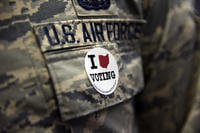The U.S. Air Force has permanently stationed its first F-35A Joint Strike Fighter aircraft in the Pacific.
The 354th Fighter Wing at Eielson Air Force Base, Alaska, accepted its first two Lightning II aircraft Tuesday. The aircraft are already gearing up for joint training alongside their stealth fighter cousin, the F-22 Raptor, also stationed in the region, according to a service news release.
"When you station the F-35 at Eielson and you have the F-22 Raptor down at Joint Base Elmendorf-Richardson, working together in the [Joint Pacific Alaska Range Complex] with our 18th Aggressor Squadron and ground training assets, you have the perfect training field for the F-35 to develop," said Col. Benjamin Bishop, commander of the 354th Fighter Wing.
Establishing the F-35s in Alaska has been a yearslong process, but marks the first step "in a journey that will continue at Eielson Air Force Base for decades to come," Bishop said in the release.
Related: Did F-35 Testing for Extreme Weather Conditions Fall Short?
A total of 54 conventional takeoff and landing versions of the F-35 are scheduled to arrive by December 2021. The base also has KC-135 Stratotankers and F-16 Fighting Falcons, which often serve as aggressor air or "red air" training aircraft to simulate air-to-air battles with jet fighter counterparts.
Eielson hosts one of the Air Force's premier exercises, Red Flag Alaska, bringing pilots and ground troops together several times a year for the purpose of enhancing tactics and techniques should friendly forces come under siege.
"We have a new mission," Bishop said in the release. "We won't look back as we pioneer the airpower frontier."
By 2022, Alaska will be home to one of the highest concentrations of fifth-generation aircraft operating in the Pacific theater and near the Arctic circle.
In an Op-Ed featured in Defense News last year, then-Air Force Secretary Heather Wilson and Chief of Staff Gen. David Goldfein outlined the strategic importance of the F-35 in the region amid the growing international interest in the Arctic, stating that Alaska would become "home to more advanced fighter jets than any place on Earth."
"Almost a decade before the Japanese invaded the Aleutian Islands, Gen. Billy Mitchell advocated building airfields, telling Congress: 'Whoever holds Alaska will hold the world,'" they wrote. "Even then, the Arctic was strategically important, and Mitchell's words underscored the role of airpower in the region. ... Today, technological advancements by potential adversaries are making this once forbidding border increasingly porous."
Adding more U.S. jets to the region also presents an opportunity for allied nations to integrate and learn from American pilots, officials have said.
For example, last year, Norway marked the first major exercise for its F-35A variant by participating in the biennial Arctic Challenge exercise in the "high north" -- a term used for the region encompassing the Nordic countries and the Arctic -- alongside U.S. F-16 pilots.
"The U.S. Air Force is a huge reinforcement or potential. We are not enough," said Svein Efjestad, policy director for the department for security and policy operations at Norway's Ministry of Defense.
Speaking to Military.com last year prior to the exercise, Efjestad said that pairing with the U.S. would bring volume, "tactical training" and advancement.
Norweigan officials at the time said they would welcome more interoperability flights with the U.S. to mix and match capabilities, especially when allied militaries could learn more about Russia's expanding activities in the region, including GPS jamming and how to thwart or manage hostile action.
The Air Force deployed F-35s to the Pacific for the first time in 2017 during a rotation to Kadena Air Base in Okinawa.
-- Oriana Pawlyk can be reached at oriana.pawlyk@military.com. Follow her on Twitter at @Oriana0214.
Read more: President Trump Orders Navy to 'Destroy' Iranian Boats that Harass US Vessels













